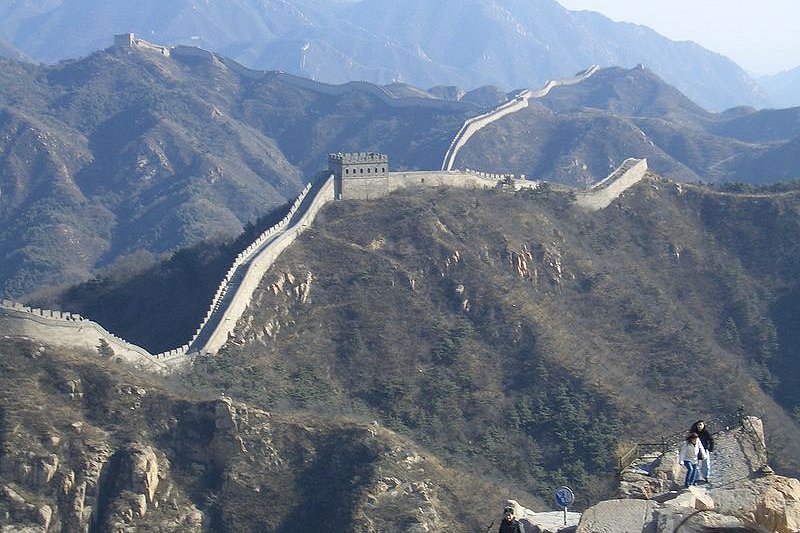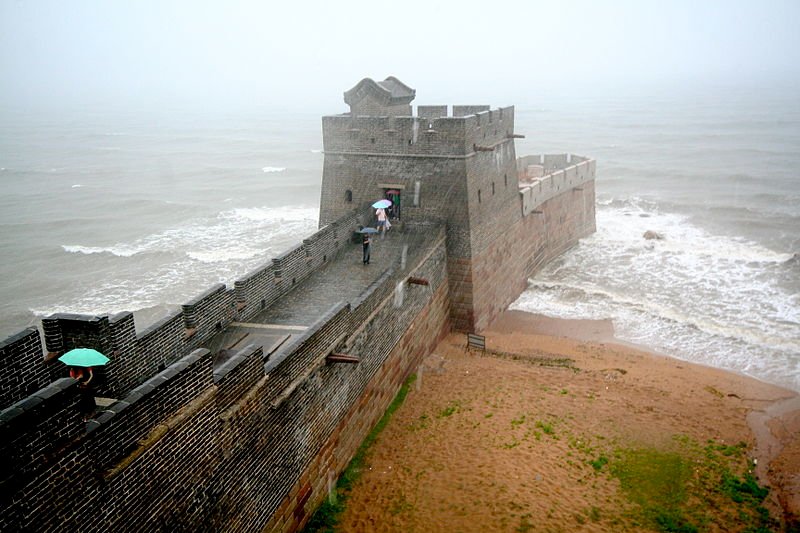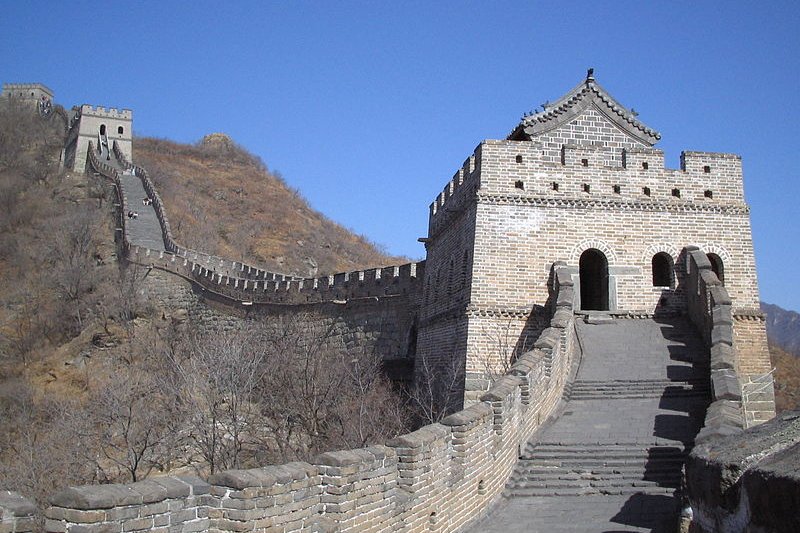 Great Wall of China
Great Wall of ChinaSource: https://commons.wikimedia.org/wiki/File:China_-_Great_Wall_8_(134019477).jpg
Author: McKay Savage

The Great Wall of China is the longest man-made structure of the ancient world. Called Chángchéng, or "Long Wall" in Mandarin, the Great Wall is actually a series of stone and earthen fortification. It was built, rebuilt and maintained from the 5th century BC to the 16th century AD, to protect the northern border of the Chinese Empire from marauders. The wall totals over 4000km in length, but is not one wall, but several. The current wall was built during the Ming Dynasty. Contrary to popular myth, it is not visible from space.
The Great Wall of China was inscribed as a World Heritage Site during the 11th session of the World Heritage Committee meeting at UNESCO Headquarters in Paris, France, on 7-11 December, 1987.
 Great Wall of China
Great Wall of China
Author: McKay Savage

The Great Wall of China is the longest man-made structure of the ancient world. Called Chángchéng, or "Long Wall" in Mandarin, the Great Wall is actually a series of stone and earthen fortification. It was built, rebuilt and maintained from the 5th century BC to the 16th century AD, to protect the northern border of the Chinese Empire from marauders. The wall totals over 4000km in length, but is not one wall, but several. The current wall was built during the Ming Dynasty. Contrary to popular myth, it is not visible from space.
The Great Wall of China was inscribed as a World Heritage Site during the 11th session of the World Heritage Committee meeting at UNESCO Headquarters in Paris, France, on 7-11 December, 1987.
 Great Wall of China
Great Wall of ChinaSource: https://commons.wikimedia.org/wiki/File:Gran_Muralla_China5173.JPG
Author: Poco a poco

Inscription Year: 1987
Type of Site: Cultural
Inscription Criteria: I, II, III, IV, VI
 Eastern end of the Great Wall at Shanhaiguan
Eastern end of the Great Wall at Shanhaiguan
Author: Poco a poco

World Heritage Site Inscription Details
Location: N 40 25 E 116 05 in the provinces, municipalities and autonomous regions of Liaoning, Jilin, Hebei, Beijing, Tianjin, Shanxi, Inner Mongolia, Shaanxi, Ningxia, Gansu, Xinjiang, Shandong, Henan, Hubei, Hunan, Sichuan, and QinghaiInscription Year: 1987
Type of Site: Cultural
Inscription Criteria: I, II, III, IV, VI
History of the Great Wall of China
Wall-building techniques were developed as early as (and probably earlier than) the 8th century BC. In the 5th century BC to 221 BC, several ancient states including Qi, Yan and Zhao were all building earthen fortifications to withstand attacks of small arms like swords and spears. When Qin Shi Huang unified China and established the Qin Dynasty in 221BC, he destroyed sections of the wall that divided his empire, and built as new wall to connect the fortifications along his northern frontier. Very little of Qin Shi Huang's wall remained today. Later dynasties continued to repair, rebuilt and extended sections of the Great Wall in a continuous effort to defend themselves. Eastern end of the Great Wall at Shanhaiguan
Eastern end of the Great Wall at ShanhaiguanSource: https://commons.wikimedia.org/wiki/File:ShanhaiguanGreatWall-end.jpg
Author: fuzheado

The Mings overcame the Mongols in 1449 to establish the Ming Dynasty. As the Mings failed to gain a clear victory, there were successive battles in the Mongols. So the Mings adopted a new strategy to keep the Mongols out, by constructing walls alll along the northern border of China. The Ming fortifications were stronger and more elaborate that the Qin. It make use of bricks and stones instead of earth. A lot of effort was invested to upkeep the wall to prevent Mongol intrusion.
From 1600 onwards, the Mings face a new threat, in the form of the Manchus. The Great Wall was able to keep the Manchus at bay until 1644, when a corrupt Ming border general by the name of Wu Sangui opened the gates of Shanhai Pass to the invaders. The Manchus swiftly grab hold of power, defeating the Mings, and establishing the Qing Dynasty, which continued until the Republican revolution in the 20th century. Under the Manchus, repair work on the Great Wall came to a stop because by then, the borders of China had extended northwards beyond the walls, and Mongolia was made part of the empire, so the wall was no longer a necessity.
 The Great Wall at Mutianyu, near Beijing
The Great Wall at Mutianyu, near Beijing
Author: fuzheado

The Mings overcame the Mongols in 1449 to establish the Ming Dynasty. As the Mings failed to gain a clear victory, there were successive battles in the Mongols. So the Mings adopted a new strategy to keep the Mongols out, by constructing walls alll along the northern border of China. The Ming fortifications were stronger and more elaborate that the Qin. It make use of bricks and stones instead of earth. A lot of effort was invested to upkeep the wall to prevent Mongol intrusion.
From 1600 onwards, the Mings face a new threat, in the form of the Manchus. The Great Wall was able to keep the Manchus at bay until 1644, when a corrupt Ming border general by the name of Wu Sangui opened the gates of Shanhai Pass to the invaders. The Manchus swiftly grab hold of power, defeating the Mings, and establishing the Qing Dynasty, which continued until the Republican revolution in the 20th century. Under the Manchus, repair work on the Great Wall came to a stop because by then, the borders of China had extended northwards beyond the walls, and Mongolia was made part of the empire, so the wall was no longer a necessity.
 The Great Wall at Mutianyu, near Beijing
The Great Wall at Mutianyu, near BeijingSource: https://commons.wikimedia.org/wiki/File:Chemin_de_ronde_muraille_long.JPG
Author: Fabienkhan

The North Pass of Juyongguan, also known as Badaling. This section was the first to open to tourists, in 1957, and remains the most visited section of the Great Wall of China, probably also the most commercialised. Located 50km northwest of Beijing, this is the section of the wall built during the Ming Dynasty.
Jinshanling, the section of the Great Wall in Ruanping county, 120km northeast of Beijing. The Jinshanling section is 10.5km long. It has 5 passes, 67 towers and 2 beacon towers. One striking aspect of the Great Wall here is the steep inclinations that it climbs.
Looking for information on Penang? Use this Map of Roads in Penang to zoom in on information about Penang, brought to you road by road.

Author: Fabienkhan

Visiting Great Wall of China, Beijing
There are three sections of the Great Wall that are usually visited by tourists to Beijing. They are:The North Pass of Juyongguan, also known as Badaling. This section was the first to open to tourists, in 1957, and remains the most visited section of the Great Wall of China, probably also the most commercialised. Located 50km northwest of Beijing, this is the section of the wall built during the Ming Dynasty.
Jinshanling, the section of the Great Wall in Ruanping county, 120km northeast of Beijing. The Jinshanling section is 10.5km long. It has 5 passes, 67 towers and 2 beacon towers. One striking aspect of the Great Wall here is the steep inclinations that it climbs.
List of World Heritage Sites in China
 Latest updates on Penang Travel Tips
Latest updates on Penang Travel Tips
 Map of Roads in Penang
Map of Roads in Penang
Looking for information on Penang? Use this Map of Roads in Penang to zoom in on information about Penang, brought to you road by road.
Copyright © 2003-2025 Timothy Tye. All Rights Reserved.

 Go Back
Go Back